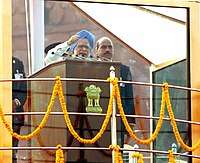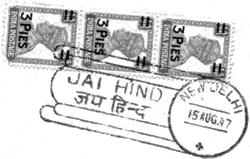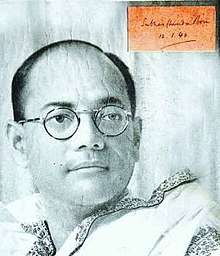Jai Hind
Jai Hind (Hindi: जय हिन्द, IPA: [dʒəj ɦɪnd]) is a salutation and slogan that originally meant "Victory to India",[1] and in contemporary colloquial usage usually means "Long live India"[2] or "Salute to India". Coined and used during India's freedom movement from the British Raj,[3][4] it emerged as a form of battle cry particularly among Indian National Army personnel (INA) and in political speeches.[5]
Etymology and nomenclature
The word "jai" is derived from jaya (Sanskrit), which means "triumph, victory, cheers, bravo, rejoice".[6] The word jaya appears in Vedic literature such as in Atharvaveda 8.50.8 and in post-Vedic literature such as the Mahabharata.[7]
History
There is a misconception that Subhas Chandra Bose coined the slogan 'Jai Hind' but Narendra Luther, a former civil servant in his book "Legendotes of Hyderabad" based on documentary evidences, interviews and research credited it to Zain -ul Abideen Hasan. He was son of a Collector from Hyderabad, who went to Germany to study engineering. Later Zain-ul-Abideen became major in INA and participated in India campaigns. "Netaji" (Hindustani: "Respected Leader") Subhas Chandra Bose wanted an Indian style salute in his army and various suggestions came from. Zain-Ul-Abideen came up with 'Jai Hind' and Netaji Bose gladly accepted it.[8]
According to grand-nephew Sumantra Bose, a historian, the phrase is devoid of any religious tone. The term became popular as a slogan and greeting of the Indian National Army organized by Subash Chandra Bose and his colleagues, particularly between 1943–45.[5] After India's independence, it emerged as a national slogan, and has been a common form of greeting the people of India by its political leaders and prime ministers such as Jawaharlal Nehru,[9] Indira Gandhi,[10] Rajiv Gandhi, P V Narasimha Rao, and others.[11][12] Indira Gandhi would end her political speeches with triple shouts of "Jai Hind".[10] Since the mid-1990s, came to be used as a greeting among the Indian Army personnel.[5]
 The Prime Minister Dr. Manmohan Singh chanting Jai Hind from the ramparts of Red Fort, Delhi
The Prime Minister Dr. Manmohan Singh chanting Jai Hind from the ramparts of Red Fort, Delhi The book "Jai Hind" authored by Ramchandra Moreshwar Karkare.
The book "Jai Hind" authored by Ramchandra Moreshwar Karkare. Independent India's first postage stamp.
Independent India's first postage stamp. Indian commemorative post-mark of "Jai Hind".
Indian commemorative post-mark of "Jai Hind".
In popular culture
A follower of Indian nationalist Subhas Chandra Bose, Ramchandra Moreshwar Karkare, of Gwalher (Gwalior) Madhya Bharat, wrote a patriotic drama Jai Hind in March 1947 and published a book in Hindi, with the same title. Later, Karkare became Congress president of Central India Province.
The Jai Hind postmark was the first commemorative postmark of Independent India. The first stamps of Independent India were issued on November 21, 1947 with Jai Hind inscribed on them, in 1.5 anna, 3.5 anna and 12 anna denominations. Along with Jai Hind, they carried images of Ashoka capital, national flag and an aircraft respectively.[13] "जय हिन्द" is also stated on the first, Independence series of Indian stamps.
The phrase is used on All India Radio at the end of a broadcast. It occurs in the patriotic song "Aye Mere Watan Ke Logo" sung by Lata Mangeshkar in 1963.[14]
Mahatma Gandhi sent a piece of crocheted, cotton lace made from yarn personally spun by himself, with the central motif Jai Hind, to British Royal couple Queen Elizabeth II and Prince Philip as a wedding gift in 1947.[15]
The phrase appeared in the early years of Air India slogans, with a 1965 Lok Sabha debate mentioning it being a part of the tagline of the government-owned national airline as "One Nation, One Leader, One India, Jai Hind".[16]
Other uses
The phrase has also given its name to
- Jai Hind (1994), a Tamil movie with Arjun Sarja as hero
- Jai Hind (1999), a Hindi film, made by actor-director Manoj Kumar[17]
- The comedy show [[Jay Hind!]JayHindNews.In ] (2009)
- Jai Hind College, Mumbai
- Jai Hind, a Gujarati newspaper
- JaiHind TV.
See also
References
- Chopra, Pram Nath (2003). A comprehensive history of modern India. Sterling Publishing. p. 283. ISBN 81-207-2506-9. Retrieved 17 February 2010.
- James, Lawrence (1997). The Rise and Fall of the British Empire. Macmillan. p. 548. ISBN 978-0-312-16985-5. Retrieved 17 February 2010.
- Ian W. Archer (2014). Transactions of the Royal Historical Society. Cambridge University Press. p. 203. ISBN 978-1-107-06386-0.
- Gyanendra Pandey (2001). Remembering Partition: Violence, Nationalism and History in India. Cambridge University Press. pp. 100–101. ISBN 978-0-521-00250-9.
- Sumantra Bose (2018). Secular States, Religious Politics. Cambridge University Press. pp. 49–50. ISBN 978-1-108-47203-6.
- Duncan Forbes (1958). A Dictionary, Hindustani & English: Accompanied by a Reversed Dictionary, English and Hindustani. W.H. Allen and Company. p. 307.
- Monier Monier-Williams. "jaya (जय)". Monier-Williams Sanskrit-English Dictionary 1899 (Updated 2009). Harvard University Press.
- https://m.timesofindia.com/india/Who-coined-the-slogan-Jai-Hind/articleshow/30939048.cms
- Benjamin Zachariah (2004). Nehru. Routledge. pp. 126–127. ISBN 978-1-134-57740-8.
- Indira Gandhi (1984). Selected speeches and writings of Indira Gandhi, September 1972-October 30, 1984. Publications Division, Ministry of Information and Broadcasting, Govt. of India. p. 273.
- Jagdish Bhagwati; Arvind Panagariya (2013). Why Growth Matters: How Economic Growth in India Reduced Poverty and the Lessons for Other Developing Countries. Public Affairs. p. 27. ISBN 978-1-61039-272-3.
- Economic and Political Weekly, Volume 24. Sameeksha Trust. 1989. p. 1325.
- Gopa Sabharwal (2017). India Since 1947: The Independent Years. Penguin Random House. p. 24. ISBN 978-93-5214-089-3.
- Chaturvedi, Mamta (2004). Filmi & non-filmi songs. Diamond Pocket Books. p. 38. ISBN 81-288-0299-2.
- "Archived copy". Archived from the original on October 8, 2015. Retrieved November 10, 2015.CS1 maint: archived copy as title (link)
- Asian Recorder. K. K. Thomas at Recorder Press. 1965. p. 6220.
- Jai Hind on IMDb
